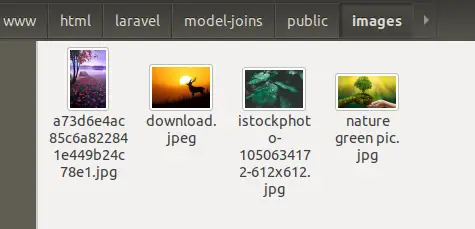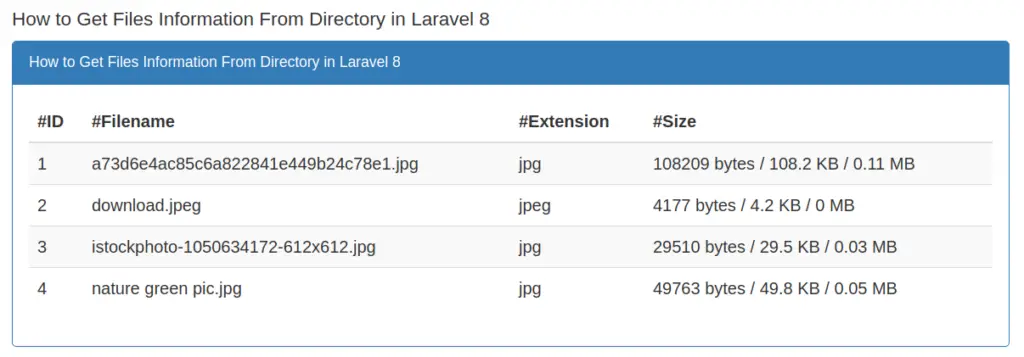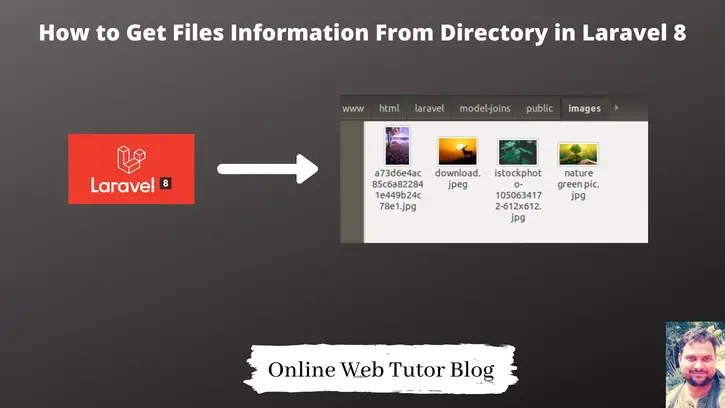Inside this article we will see the concept of How to get files information from directory in laravel 8. In laravel application we store public accessible files inside /public folder.
By this tutorial you will get the idea about finding file information from any directory inside laravel application. In a folder we store files of any type like image, pdf, doc etc.
File information like it’s name, size, extension etc. This tutorial will use laravel Filesystem concept to get file details. Tutorial will be super easy to understand and implement.
Learn More –
- Concept of Route Middleware in Laravel 8 Tutorial
- Concept of Route Model Binding in Laravel 8 with Example
- Concept of Trait in Laravel 8 Tutorial with Example
- Create Custom 404 Page in Laravel 8 | Page Not Found
Let’s get started.
Laravel Installation
We will create laravel project using composer. So, please make sure your system should have composer installed. If not, may be this article will help you to Install composer in system.
Here is the command to create a laravel project-
composer create-project --prefer-dist laravel/laravel blog
To start the development server of Laravel –
php artisan serve
URL: http://127.0.0.1:8000
Assuming laravel already installed inside your system.
Analyze Public Folder
Suppose in a laravel application we have few images into /public/images folder.

We can see 4 images available in images folder.
Let’s find the file information of these in laravel.
Create Controller
Next, we need to create a controller file.
$ php artisan make:controller FileController
It will create a file FileController.php at /app/Http/Controllers folder.
Open FileController.php and write this complete code into it.
<?php
namespace App\Http\Controllers;
use Illuminate\Http\Request;
use File;
class FileController extends Controller
{
public function index()
{
$files_info = [];
foreach (File::allFiles(public_path('images')) as $file) {
$files_info[] = array(
"filename" => $file->getFilename(),
"filesize" => $file->getSize(), // returns size in bytes
"fileext" => $file->getExtension()
);
}
return view('file-details', [
"files_info" => $files_info
]);
}
}- File::allFiles(public_path(‘images’)) Returns all files from /public/images folder.
- $file->getFilename() Returns file name
- $file->getSize() Returns file size in bytes
- $file->getExtension() Returns file extension
Create Blade Layout File
Go to /resources/views folder and create a file with name file-details.blade.php
Open file-details.blade.php and write this complete code into it.
<html>
<head>
<title>How to Get Files Information From Directory in Laravel 8</title>
<link rel="stylesheet" href="https://maxcdn.bootstrapcdn.com/bootstrap/3.4.1/css/bootstrap.min.css">
</head>
<body>
<div class="container" style="margin-top: 30px;">
<div class="row">
<div class="col-md-12 offset-md-3 mt-5">
<h4>How to Get Files Information From Directory in Laravel 8</h4>
<div class="panel panel-primary">
<div class="panel-heading">How to Get Files Information From Directory in Laravel 8</div>
<div class="panel-body">
<table class="table table-striped">
<thead>
<tr>
<th>#ID</th>
<th>#Filename</th>
<th>#Extension</th>
<th>#Size</th>
</tr>
</thead>
<tbody>
@php
$count = 1;
@endphp
@foreach ($files_info as $item)
<tr>
<td>{{ $count++ }}</td>
<td>{{ $item['filename'] }}</td>
<td>{{ $item['fileext'] }}</td>
<td>
{{ $item['filesize'] . ' bytes' }} /
{{ round($item['filesize'] / 1000, 1) . ' KB' }} /
{{ round($item['filesize'] / (1000 * 1024), 2) . ' MB' }}
</td>
</tr>
@endforeach
</tbody>
</table>
</div>
</div>
</div>
</div>
</div>
</body>
</html>Create Route
Open web.php from /routes folder and add this route into it.
# Add this to header
use App\Http\Controllers\FileController;
//...
Route::get('file-details',[FileController::class, 'index']);
Application Testing
Run this command into project terminal to start development server,
php artisan serveURL: http://127.0.0.1:8000/file-details

We hope this article helped you to How to Get Files Information From Directory in Laravel 8 Tutorial in a very detailed way.
If you liked this article, then please subscribe to our YouTube Channel for PHP & it’s framework, WordPress, Node Js video tutorials. You can also find us on Twitter and Facebook.
Read more